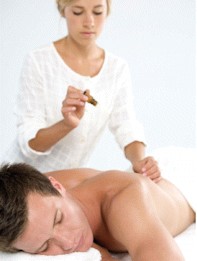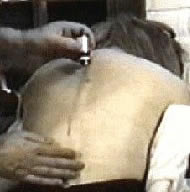Aromatherapy: It's Far More than Just the Smell
The therapeutic application of aromatic compounds — the chemistry of essential oils
Aromatherapy: It’s more than you may think
 You come home from work feeling like road kill. So, you light your scented candle or slip into a fragrant bubble bath. Maybe you do both. You lay back, close your eyes and listen to a little Mozart. Or, you have a massage with an aromatic massage oil, with Pachelbel’s Kanon in D caressing your soul.
You come home from work feeling like road kill. So, you light your scented candle or slip into a fragrant bubble bath. Maybe you do both. You lay back, close your eyes and listen to a little Mozart. Or, you have a massage with an aromatic massage oil, with Pachelbel’s Kanon in D caressing your soul.
Ah! Aromatherapy. What a great stress-buster.
But, is this all there is to aromatherapy? It’s not even close.
What’s commonly viewed as aromatherapy emphasizes fragrancing — it is aromatherapy, after all. It’s primary goal is relaxation or stress reduction through the soothing effects of fragrance — and the emotional response it generates.
And, while it’s true that aroma can reach deep down inside of us, and influence us in profound ways, true aromatherapy is far more than just the stress-busting effects of fragrancing. It offers a holistic approach to supporting health and wellness, through the powerful therapeutic properties of the aromatic molecules found in pure, therapeutic-grade essential oils.
Aromatherapy is so much more than just the smell.
So, what is aromatherapy, really?
In its most basic terms, aromatherapy is all about the chemistry.
- The fragrance of an essential oil is an expression of its chemical constituents.
- Your response to the fragrance of an oil is due to the therapeutic properties of its chemical constituents.
- The many benefits of the topical application or ingestion of essential oils are due to its chemical constituents.
- The frequency of an essential oil — and its ability to uplift and invigorate — is due to the its chemical constituents.
It’s all about the chemistry; it’s about the infusion of aromatic molecules into your body systems, through the application of pure, therapeutic-grade essential oils, to support wellness. This can be accomplished either by diffusion or direct inhalation, topical application of the oils (such as anointing or massage) or by ingestion. (Note: It cannot be accomplished through scented candles.)
For this reason, I prefer the term aromatics therapy. This seems to convey the idea better. (After all, the man who coined the term we know as “aromatherapy” was a Frenchman. Dr. René-Maurice Gattefossé called it “aromathérapie“: the therapeutic use of aromatics. His use of lavender oil had little to do with its fragrance, but everything to do with its chemistry — the therapeutic properties of the oil’s chemical constituents.)
Aromatherapy, then, is about much more than just the smell.
Three Models of Aromatherapy
There are three models — or schools of thought — in aromatherapy: French, German and English.
- The English model advocates diluting a tiny amount of essential oil in a vegetable oil base (usually at a 1-3% concentration), and massaging the body to produce a relaxing effect and relieve stress.
- The French model prescribes the ingestion of therapeutic-grade essential oils, commonly done by adding several drops of an oil to honey, a piece of bread, or a small amount of vegetable oil, and taking it orally. It also relies on the neat (that is: undiluted) topical application of the oils.
- The German model focuses on the inhalation of essential oils, based on the belief that the effect of the oils’ aromatic compounds on the brain may directly improve the function of many body systems.

Each of these models has its benefits; and, together, they show how versatile and powerful aromatherapy — the therapeutic use of essential oils — can be.
Fortunately, we don’t have to choose one model; we have the opportunity to blend these models together into an integrated approach to aromatherapy, together with the Vita Flex Technique, the auricular technique and the AromaTouch® Technique, giving you the best possible results from your aromatherapy experience.
How does aromatherapy work?
The ability of the chemical constituents of essential oils to act on both the mind and the body, makes them truly unique therapeutic agents.
Three qualities of the oils, working in harmony, give aromatherapy a wide array of unique health benefits: emotionally, physically and mentally. Pure, therapeutic-grade essential oils are powerful agents for the support of natural health and wellness because of their:
- Fragrance, through which the power of the aromatic molecules is routed from the olfactory bulb, directly to the center parts of the brain, where they influence hormonal balance, boost the immune system and balance body systems. Fragrance can have direct influence on your emotions and memory, as well, enabling aromatherapy to have a powerful positive influence on almost every aspect of your health.
- Chemistry and the activity — or, therapeutic action — of aromatic molecules on the cells of the body. There are at least 3,000 known chemical compounds found in essential oils. A fairly simple oil may contain anywhere from 80 to 300 of these; and, an essential oil like lavender or ginger is far more complex. All of these aromatic compounds have scientifically documented therapeutic actions, which work in synergy with one another in any one oil, and can be blended to create specific therapeutic effects.
- Frequency, something like the xi (or chi) of tai chi, xigong or acupuncture, which enables the oils to actually raise the energy levels of your body, to enhance immune function and promote a greater sense of overall health and well-being.
And, while the general understanding of aromatherapy emphasizes only the fragrance of the oils, if your oils don’t provide you with each of these, you’re not getting all you can from your aromatherapy experience.
How to use your essential oils to their fullest advantage
Two of the most powerful aromatherapy application methods are cold-air or ultra-sonic diffusing and neat (or undiluted) topical application.
- Diffusing therapeutic-grade essential oils through a cold-air or ultra-sonic diffuser is a wonderful way to experience the powerful effects of essential oils.
- Direct application of neat essential oils to the skin has benefits that must be experienced to be believed.
Two of the most effective methods for the direct application of essential oils are the AromaTouch and the Vita-Flex Techniques.
Another method, closely related to diffusing, is direct inhalation. Just place a few drops of a therapeutic-grade essential oil into the palm of one hand, rub your palms together clock-wise (which increases the frequency of the oil and helps to harmonize it with your body’s energies), cup your hands over your nose and mouth and inhale deeply several times. An alternate method is to apply oils to a handkerchief or tissue and inhale (think in terms of those French dandies in Louis’ court). Essential oils may also be dropped on your pillow at night, to create a very pleasing — and therapeutic — sleeping environment.
Other ways to use essential oils:
- In humidifiers and vaporizers: Some essential oils, like lemon, peppermint and frankincense, work especially well for this. But, eucalyptus, melaleuca, thyme, oregano and wild orange can also be used in this way, to provide protection from seasonal and environmental threats.
- In a crystal salt fog ionizer: This ionizer is a great way to create the perfect, relaxing and therapeutic effect in any room. It not only gives you the many benefits of ionized salt air, it’s the perfect way to diffuse essential oils for their therapeutic effects.
- In the bath or shower: dōTERRA® oils can be added to bath gels or shampoos; or, if you have the skills, you can create your own aromatic soaps. These are wonderful ways to experience the benefits of aromatherapy.
- As an alternative to synthetic fragrances: Essential oils are all-natural and have long-lasting, distinctive aromas that have never failed to bring appreciative smiles to the faces of those I’ve met. And once you’ve used them for awhile, you’ll never settle for toxic, allergy-inducing synthetic fragrances again.
- In compresses: Applying a compress over the oils produces a deep, soothing effect. Simply rub a few drops of essential oil (either neat or diluted, depending on the essential oil used) onto the desired area, then cover with a damp towel, and cover that with a dry towel. Leave this in place for 10 to 60 minutes (replace the damp towel with a warm one every 5-10 minutes, to maintain the temperature). The warmth of the towel, along with the moisture, drive the oils deep into the tissues.
- As dietary supplements: Many essential oils may be diluted in an oil-soluble liquid (such as almond or hemp milk, grade B maple syrup, honey or whole, raw milk) and taken orally.
- In cooking: Essential oils can be used instead of herbs, with the most wonderful results. They are much more potent and flavorful than dried herbs, and can really make your pot roasts or hams will sit up and sing. For best results, they should be added after — or near the end of — cooking, to preserve their therapeutic benefits.
- In cleaning: Many of the oils are very cleansing or purifying. Adding a few drops of lemon, peppermint, Citrus Bliss® or Purify to your laundry, dishwasher or dishwater helps to cleanse and purify. It also makes things smell great. In the laundry, you can add a few drops to the wash water; but, an even nicer effect is created by adding a few drops to a moist wash cloth and putting it in the dryer with wet clothes.
Essential oils as a boost to other healing modalities
Clinical research has demonstrated that aromatherapy has powerful beneficial effects, when supporting other healing modalities.. Essential oils can be used in conjunction with:
- Massage therapy: Essential oils can greatly enhance the relaxing and restorative effects of massage. The oils aid in soothing stressed muscle and other soft tissues, improve circulation and promote lymph drainage. Just add your favorite essential oil to a massage base oil, and you’re ready to go. Applying the oils neat, and layering a massage oil over that, is also very effective.
- Reflexology: Adding essential oils, especially with the Vita-Flex Technique, can greatly enhance the effectiveness of this healing practice. The frequency of the essential oils makes a perfect partnership with the energy of the reflexologist.
- Acupuncture: As with reflexology, essential oils are a natural enhancer of the effects of this practice. It makes a wonderful alternative to the use of electrical stimulation, used with acupuncture by so many chiropractors today.
- Chiropractic: One chiropractor, who uses essential oils in his practice, states that using certain essential oils makes adjusting 40% easier, and the results last 65% longer.
As you can see, aromatherapy involves a lot more than scented candles to help you relax. My use of essential oils has enhanced every aspect of my life. The FDA won’t let me go into detail here, but I simply can’t imagine my life without them. They have literally re-defined for me the meaning of “health”. I’ve come to accept these aromatic miracles with great thankfulness; as treasured gifts from God.
